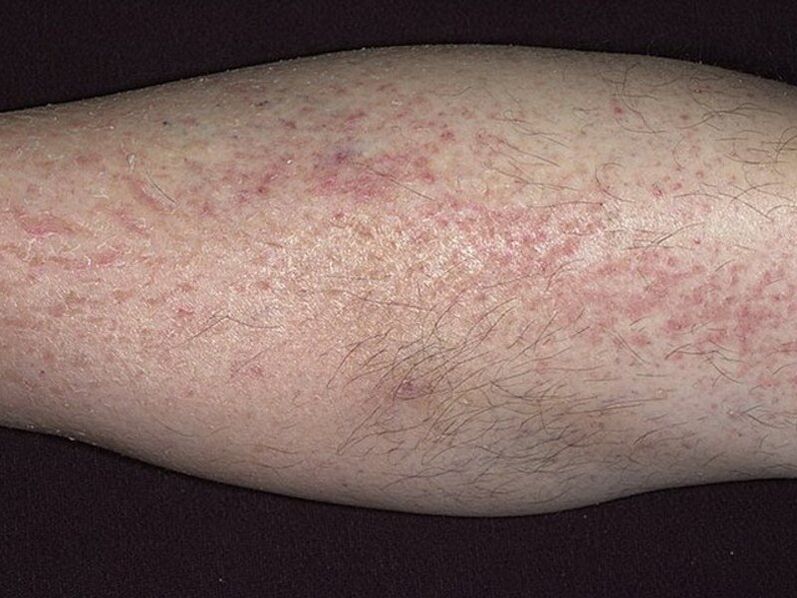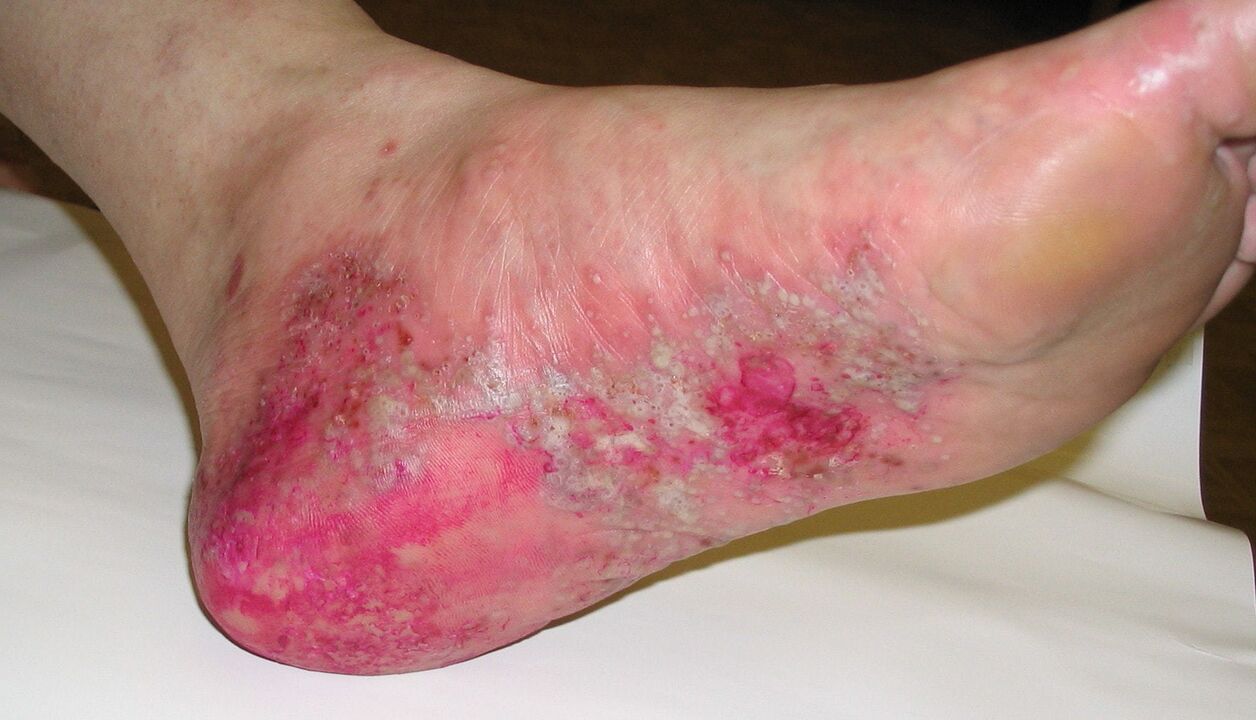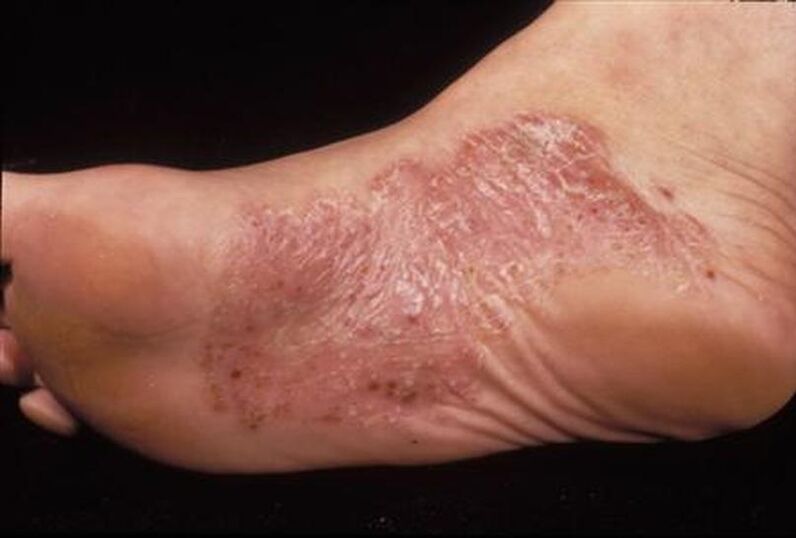
As the exact etiology of the process is unknown, the search for the most effective treatment is appropriate. Hormonal drugs are often used to treat the disease, which only relieve external symptoms, while remission lasts several months, and the drugs themselves can cause side effects. The remedy for psoriasis of the feet is prescribed by a dermatologist, while the complex of traditional methods may include folk remedies for the treatment of psoriasis.
There are many ways to treat foot psoriasis. As a rule, the treatment of psoriasis of the legs includes systemic and local therapy, the appointment of physiotherapy, adherence to the regime and diet.
Classification of psoriasis of the lower extremities
On the feet, psoriasis occurs in only 30% of cases of skin lesions. Dermatologists classify the initial stage of the disease in this part of the body into two groups:
- Psoriasis type 1. Affects the feet of children, adolescents, older men and women due to their genetic predisposition to this disease. In total, at least 60% of all cases had relatives who suffered from this disease. Most often, psoriasis of the lower extremities is passed on to offspring born in the 3-4th generation. The treatment of hereditary psoriasis is long-term and requires the systematic use of special drugs to stop the spread of plaque from the surface of the legs to the trunk and other parts of the body.
- Psoriasis type 2. This is an already acquired form of the disease that develops due to the presence of risk factors listed above. The age group of patients with psoriasis of the feet are people who are 40 years old and older. Often these dermatological patients abuse alcohol, eat unhealthy food, work in companies with harmful working conditions or have experienced a morally difficult stressful situation in their lives. In such patients, the initial stage of the disease is always acute and with a clear clinical picture. One month after the appearance of the first red spots, the knee and hip joints begin to be affected. It all depends on the location of the plaques.
Prevention
The fact that the disease is much easier to prevent than to treat, not a secret.
This statement is true for psoriasis completely. To prevent the development of psoriasis, we should observe the following recommendations:
- Avoid emotional tension and stress. Keep a positive attitude towards life, do not worry about trifles;
- Leading a healthy lifestyle, do not abuse alcohol, smoke and also does not use drugs in any case;
- Treat promptly outbreaks of infections in the body, strengthening the general immunity;
- rub the skin with moisturizers prevent dehydration and dryness;
- do not neglect such an effective means of prevention as a people. Sometimes it is enough to brush the areas of skin allergies with appropriate herbal creams to not hear never diagnosed psoriasis.
Caring for the affected skin
If there are plaques and rashes on the feet, they should be smeared with special preparations with moisturizing ingredients. It is good if the composition includes anti-inflammatory and immunostimulating substances.
Do not lubricate the affected areas of the skin with aggressive products containing high concentrations of alcohol. The skin should not be dehydrated.
Particular care should be taken to avoid injury and damage to the skin. It is certainly known that they provoke new rashes that are not easily treated. It is worth using only soft, non-traumatic bathroom accessories.

Diet
Proper nutrition is very important. Often, dietary disorders recommended by a doctor do not allow psoriasis to be treated for many years.
Alkaline foods in the diet should be two to three times more than acidic. Alkaline foods include non-acidic fruits and vegetables. Alkaline mineral water can help. You need to monitor the timely emptying of the intestines, use products that improve peristalsis
Complications
Complications of psoriasis are characterized by the appearance of concomitant diseases. The cardiovascular system suffers the most, which often leads to heart attack or coronary heart disease. In some cases, the disease can provoke diabetes.
The treatment of psoriasis of the fingers requires an integrated approach and the most important time. Therapeutic actions should be aimed primarily at reducing foci of inflammation. Psoriasis on the hands often spreads to the nails, which should not be allowed. Otherwise, the treatment will take much longer.
Medical treatment
The treatment must be complex, so the drugs must be different. Remember to use:
- Creams and ointments.
- Antihistamines.
- Medicines for the gastrointestinal tract.
- Immunosuppressants.
This is a basic treatment that always helps with mild stages of psoriasis.
Physiotherapy
Physiotherapy is used as one of the stages in the treatment of psoriasis. These procedures are based on the use of various natural factors, therefore helping to stop the course of the disease. The patient undergoes a course of infrared and ultraviolet radiation, acupuncture and cryotherapy.
Folk methods
Folk medicine is rich in recipes to eliminate the symptoms of the disease and achieve long-term remission. First of all, different baths have proven themselves well:
- with sea salt;
- with herbal decoctions.
Baths with bay leaf are effective. For cooking, pour 20 g of leaves with 2 cups of water and cook for 10 minutes on low heat. Once the broth has cooled, keep the affected hands or feet in it for at least half an hour.
The skin of the hands or feet affected by psoriasis can be wiped with a tincture of juniper, birch tar or celandine juice. Sea buckthorn oil is recommended to lubricate the nails to strengthen them.
What does psoriasis of the feet look like?

The initial form of the disease does not cause serious discomfort to the patient. Manifested by mild itching and redness of the skin. Gradually the intensity increases and plaques with a pink or red tinge appear on the legs. The size of the papules is within 3-5 mm, with further development the spots grow and connect with each other.
Typical manifestations are yellowish or white scales, they are easily scraped, but the peeling in this case increases. If you get rid of peeling, you can see a red glossy film. Removing it provokes the release of a drop of blood, which in medicine is called bloody dew.
Psoriasis formed on the soles of the feet, accompanied by unbearable itching. Patients cannot resist the urge to comb the affected area. This opens access to a bacterial infection, which complicates further treatment.
Why psoriasis of the feet develops
Foot psoriasis is a chronic skin pathology with a hereditary predisposition. The development of the disease is facilitated by the influence of predisposing factors. Factors predisposing to the development of psoriasis of the feet:
- Injuries to the limbs - abrasions, cracks, wounds. In persons predisposed to this pathology, they often become inflamed, accompanied by itching, combed. Against this background, psoriatic rashes appear. These causes most often cause psoriasis in the knee joints in children, adolescents and athletes.
- Skin diseases and abrasions of the feet. Especially often the disease develops against the background of fungal infections. It is important to wear tight shoes in which your feet sweat and hurt.
- Metabolic disorders, obesity, diabetes, endocrine diseases, age-related hormonal disorders, pregnancy. Any hormonal imbalance can cause the disease.
- All chronic processes and foci of infection leading to intoxication of the body.
- High emotional, mental and physical stress.
- Improper nutrition, intestinal dysbacteriosis.
- Immune disorders.
Treatment with folk remedies
Very often the treatment of psoriasis of the feet is not limited to traditional medicine. It is better to combine your efforts with recipes for effective traditional medicine.
The most commonly used recipe for decoctions, ointments, baths, compresses to get rid of psoriasis.
Open up
To prepare a medicine that can relieve the acute symptoms of the disease, you will need celandine and oregano, taken in equal proportions, add to them chopped licorice root, which should be 2 times more than each of the previous components and take threetimes more strings. All this mixture should be poured with boiling water and kept for a quarter of an hour. Then strain the infusion and take half a cup twice a day. The greatest effectiveness can be achieved if psoriasis has just begun to appear.
Ointment
Birch tar is mixed with olive oil, the resulting mixture is applied to the plates as often as possible to achieve maximum effect.
Baths
For these purposes is suitable infusion of celandine, which will not only help eliminate rashes, but will also normalize the functioning of the body.
The celandine is poured with boiling water, insist for at least an hour, filtered and added to a warm bath. The procedure for taking a bath with celandine should not exceed 10 minutes in time. This method can become everyday.
Compresses
The potatoes did well here. To prepare the compress, you will need to grate the raw potatoes on the smallest grater. Then the juice is squeezed from the resulting mass and applied to the affected areas, the foot is wrapped with a film or bag on top and put on a warm sock. The potato compress lasts for several hours, otherwise the effect will not be achieved.
Characteristics of the rash
The clinical picture of psoriasis of the feet is manifested depending on the course of the disease, or rather its stage.
There are the following stages of psoriasis:
- Initially. The rash at the very beginning of the disease looks like acne, having a slightly convex shape. In addition, silver-steel scales begin to form on each papule;
- Progressive. The rash appears more and more, and the papules begin to increase in diameter and merge together, forming a continuous zone of damage. This whole process is accompanied by severe unbearable itching;
- Sharp. The disease, entering a stage of acute development, is accompanied by new rashes, while the old ones stop growing, starting the process of peeling;
- Stationary. The new elements of the rash no longer appear, and the affected areas of the skin are completely exfoliated. A pigmentation zone forms at the site of the previous plaques;
- Regression. At this stage, the disease is characterized by cleansing the skin of psoriatic signs, the overall well-being of the patient is greatly improved.
Treatment and diagnosis
Diagnosis and treatment of psoriasis of the feet is performed by a dermatologist, the method is very simple and consists of a simple examination of the skin, blood tests (general and biochemical). Modern medicine does not have the means to completely cure psoriasis. In some cases, treatment is used to relieve the condition and remission of symptoms.
It depends on many factors such as:
- gender of the patient;
- age group;
- place of residence (climate zone);
- activities (work, etc. );
- stage of psoriatic lesions.
Treatment with topical drugs
In addition to products that moisturize the skin, the dermatologist may prescribe the use of topical preparations that are easy to use at home:
- products containing coal tar, they help to slow down the growth of psoriatic plaques and keratinized scales.
- salicylic acid solution allows you to remove and exfoliate scales with great efficiency;
- Corticosteroids made in the form of gels are applied to the skin and covered with a bandage. This drug slows the growth of new psoriatic plaques.
Systemic drugs
If topical medications cannot cope with the onset of psoriasis, then other groups of medications are prescribed.
Combination therapy consisting of retinoids and light therapy is often used to treat foot psoriasis. As a rule, ultraviolet therapy or point laser therapy is prescribed.
If all the methods mentioned above did not help, then drugs that selectively affect the immune system may be indicated.
Foot psoriasis is a very unpleasant disease, but you should know that it is not life-threatening, although it significantly reduces its quality. Rare cases are characterized by the fact that the inflammation does not manifest itself in any way for several years. However, at the first symptoms you should immediately consult a doctor and not self-medicate - this will help avoid the development of the disease and complications.
How does psoriasis of the feet appear?

The rash with this type of lesion is concentrated on the foot and the back of the foot. They have the form of classic psoriatic plaques - areas of inflamed skin, a few millimeters above the surface of healthy tissues covered with grayish scales. The development of the pathology is accompanied by the formation of calluses, hyperkeratosis (thickening) of the skin in these areas develops. As the disease worsens, deep cracks appear, the epidermis becomes intensely red. Very often, due to the external manifestations of this form of the disease, it is confused with the development of diseases such as eczema, fungal lesions and signs of secondary syphilis. The photos will help to accurately identify psoriasis of the feet.
Foot psoriasis: causes
The causes of foot psoriasis are not completely known. Absolute certainty exists only with regard to the importance of the hereditary factor for the occurrence of the pathology. All other causes act only as possible provoking factors. They include:
- weakening of the body's immune system;
- transmitted viral and bacterial, in particular streptococcal infections;
- stress, depression;
- the presence of excessive sweating of the feet;
- hormonal changes in the body;
- violation of metabolic processes.
Manifestations of psoriasis of the feet: photo
In addition to the visible inflammation, redness of the skin, the pathology also has symptoms such as itching, burning, pain of varying intensity in the affected area. This creates significant discomfort for a person, as the movements when walking are difficult.
Due to the roughness of the epidermis of the legs, the plaques do not always flake, although there may be such a sign. It depends on the hydrophilicity of the tissues in the patient.
Psoriasis of the feet: treatment
Before prescribing treatment for psoriasis of the feet, the doctor should conduct an external examination of the pathological area to visually distinguish the disease. Today in medicine there are no special methods for further research, as the disease is of non-infectious origin and has not been fully studied.
The treatment of psoriasis of the feet is carried out in a complex way, ie the drug approach is combined with a course of physiotherapy procedures that can significantly alleviate the patient's condition. The use of specific drugs - cytostatics - is already happening with a significant progression of the disease. In the initial stages of the disease, drugs in the form of gels or ointments are used topically (sulfur, salicylic), corticosteroids are prescribed. This is done to reduce the negative effect of pharmacological preparations on the patient's body. In addition, a course of vitamin therapy, immunomodulatory and antihistamines is prescribed. Pictures of psoriasis of the feet are widely available on the Internet.
Signs of disease
The initial stage of psoriasis of the feet in most cases is considered by doctors to be an allergic reaction to some external irritant. Especially if the patient seeks medical help in the summer, when there are plenty of different allergens in the environment.
The signs of foot psoriasis in the initial stage are as follows:
- The first small pink rashes or red spots appear in places where the skin most often rubs against the inner surface of clothing. This can be the knees, groin or ankles.
- Skin neoplasms always have a regular shape in the early stages with clearly traceable boundaries. After 3-5 days, they increase in size and form a single reddish-pink plaque with an oval or rounded shape.
- The spots are gradually covered with a white coating, which forms keratinized skin cells. These are many scales that come off easily when you touch the damaged surface of the skin.
- At all stages of the initial stage of the disease a person feels severe itching of the skin of the feet. When you try to scratch an itchy area of the body, you feel severe pain.
- Taking antihistamines only temporarily relieves the itching sensation, but is not able to stop the further spread of the red rash and spots. This is a key factor indicating that the dermatological problem is not related to an allergic skin reaction to external irritants.
The initial stage of psoriasis of the feet
The first signs of scaly lichen on the legs are associated with increased sensitivity to pain, as well as itching.
Depending on the manifestations, you can see what stage of the disease we are talking about.
The initial stage of this disease manifests itself in the form of a rash of red or bright pink color.
Initially, the rash is small and takes up minimal skin.
Over time, the rash from individual parts develops into a large spot, which stands out with a red tinge.
Due to this association, psoriatic plaques form, which rise slightly above the surface of the skin. Inflamed areas are accompanied by severe itching, which greatly torments patients.
Then peeling of the affected tissues begins.
Symptoms of the disease
Most often, scaly lichens on the legs affect the knees, thighs, feet and the area near the ankle. These areas show symptoms such as:
- severe persistent itching;
- swelling in the affected areas;
- the appearance of psoriatic papules;
- psoriatic arthritis;
- violation of the structure of the nail plates of the feet.
Characteristic features
Reddish areas appear on the skin, which rise slightly above the skin. These rashes become noticeable immediately, as their bright color, characterized by an inflammatory process, stands out against the background of clean areas.
Later they form a large affected area. Psoriatic plaques that appear afterwards will begin to peel off, but if removed, they will bleed a little or simply leave a red smooth surface.
What is psoriasis of the feet
This skin disease is not considered contagious, but it causes physical and psychological suffering to a person. Psoriasis that occurs once after treatment may not remind itself for a long time. Often the disease recurs for unknown reasons. In psoriasis there is a disorder in the formation of skin cells, their accelerated development. With the onset of the inflammatory process that occurs in the legs, a superficial lesion is observed:
- Stop yourself;
- legs
- fingers;
- thighs;
- areas around the joints;
- nails.
A characteristic feature of psoriasis is that its origin is not fully understood, which complicates treatment. Inflammation of the skin of the feet is aggravated by problems with human motor activity. Unfortunately, it is not possible to radically address the issue of complete elimination of psoriasis. The patient is assisted by:
- relief of painful symptoms;
- slowing the growth of rashes on the legs;
- alleviation of the condition;
- restoration of working capacity;
- return to a full life.
The onset of psoriasis can be characterized by the formation of a rash - pink papules on the surface of the skin of the feet. As the disease progresses:
- swelling of the joints;
- development of psoriatic arthritis;
- redness;
- thick scaly plaques;
- cracking of the skin;
- unbearable itching;
- bleeding;
- combining individual elements into a common lesion.
Manifestations of psoriasis vary depending on the site of damage to the skin of the feet. The following characteristics are typical:
- on the thighs - large areas with rashes, scaling;
- nails - thicken, exfoliate, change the color and shape of the nail plate;
- the joints of the legs - become inflamed, their mobility is limited;
- psoriasis of the feet - the feet are covered with a thick keratinized layer of cells, there are cracks, severe redness, sensitivity increases.
Although the disease is common, doctors cannot say the exact reason why it occurs. There are provoking factors that cause this skin pathology of the legs and other parts of the body. Psoriasis can start as a result of:
- hereditary predisposition;
- hormonal insufficiency in the body;
- skin injury;
- excessive hygiene;
- infectious diseases;
- stressful situations.
Medical science believes that the cause of psoriasis lies in the failure of the immune system, disorders of epithelial cells. Adverse factors can provoke skin disease of the feet, including:
- psycho-emotional stress;
- exposure to chemicals;
- disorders of metabolic processes;
- dry thin skin;
- alcohol intoxication;
- climate change;
- varicose veins of the legs;
- pathologies of lipid metabolism.
To help a sick baby in time, a proper diagnosis is needed. In childhood, psoriasis can be confused with other skin diseases of the feet. Timely treatment of a sick child will help save him from severe symptoms and complications. The appearance of psoriasis in a baby is a consequence of:
- allergies;
- helminthic infestations;
- lack of vitamins;
- hereditary factors;
- failures in the immune system.
The symptoms of the disease in a child are different:
- psoriasis of the feet may be in the form of continuous reddening of the surface, which can not be touched due to pain;
- when the nails are damaged, points similar to a needle prick are observed;
- in the skin folds of the legs there are rashes that flake, itch and do not allow to sleep;
- large areas of redness with cracks and bleeding form on the thighs.
The patient's condition and symptoms depend on the stage of development of psoriasis. Pathologies arising on the surface of the feet are constantly changing over a long period of time. There are several stages in the development of psoriasis:
- initially - the first rashes appear, redness, swelling - a situation favorable for treatment;
- progressive - new plaques are actively formed, existing ones, increase in size, everything is accompanied by intense itching, scaling.
In the following stages of psoriasis, changes in the course of the disease are observed:
- acute - the progression of the growth of the rash stops, scales appear;
- stationary - new papules do not appear on the feet, the old ones form a layer that gradually peels off, leaving stains;
- regressive - the disease stops, the plaques disappear without a trace, all unpleasant symptoms disappear, the patient is healthy.























